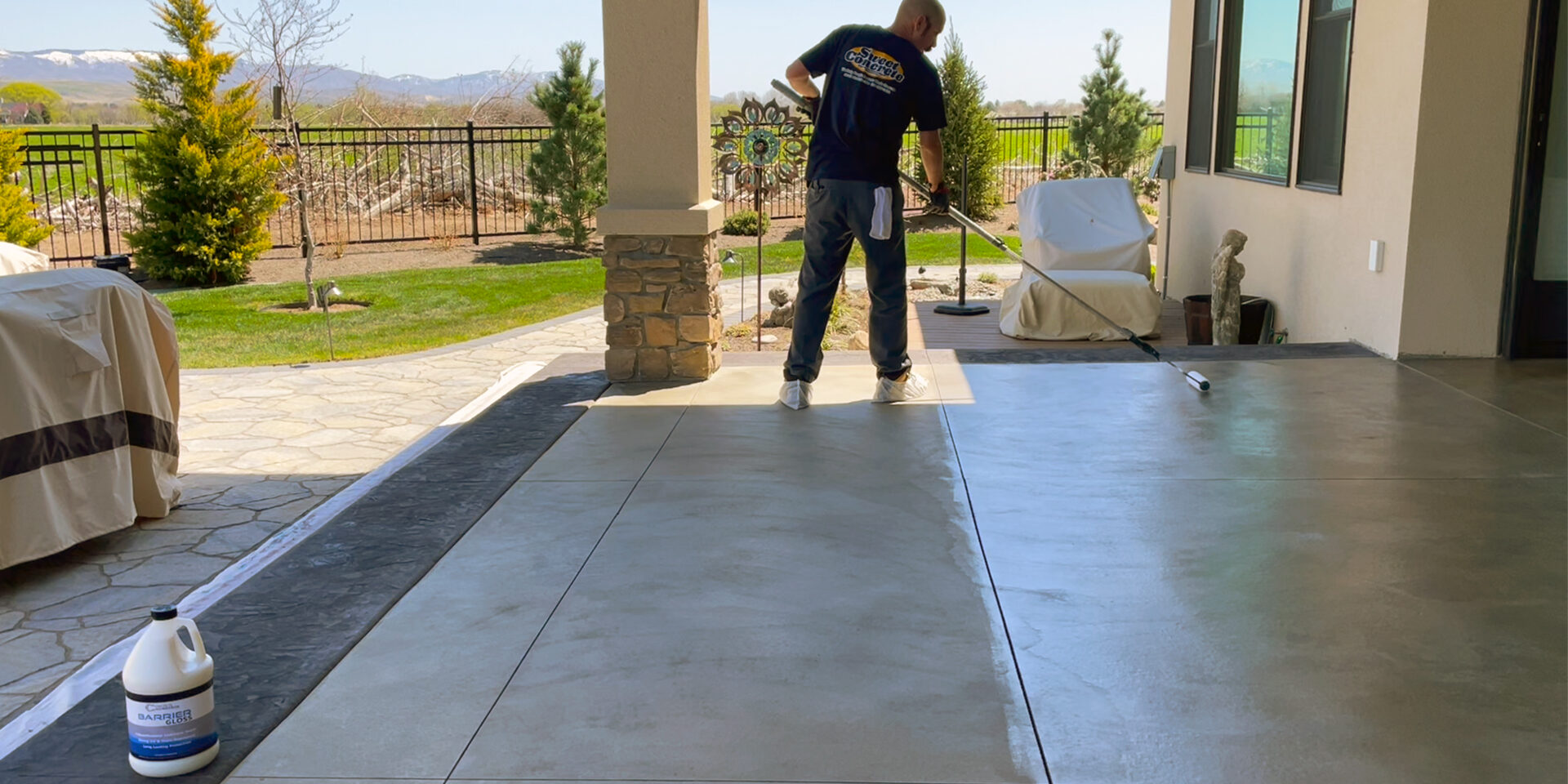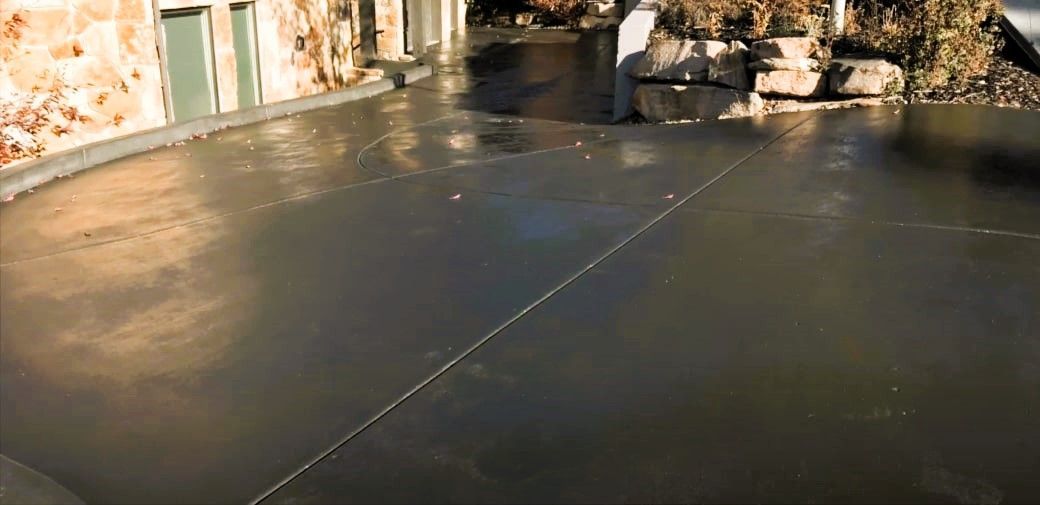Everything About Stained Concrete: A Comprehensive Guide to Its Advantages and Applications
Stained concrete has become a preferred choice for both residential and business rooms. Its capacity to combine visual charm with usefulness makes it an appealing alternative. Different discoloration methods supply a variety of shades and finishes, permitting modification. The advantages prolong beyond look. Comprehending its applications and upkeep demands is necessary for anyone considering this versatile material. The subtleties of stained concrete welcome additionally expedition.
What Is Stained Concrete?

Discoloration can be put on numerous surfaces, consisting of floorings, driveways, and patio areas, making it a functional alternative for both interior and outside spaces. The treatment can accomplish an array of appearances, from natural tones to bold, modern-day layouts. Unlike paint, stained concrete keeps its look over time, as it ends up being an important component of the concrete itself. Generally, stained concrete acts as an efficient approach for transforming normal concrete right into aesthetically striking surfaces.
Advantages of Stained Concrete
Stained concrete deals significant benefits, specifically in visual charm and longevity - stained concrete. Its dynamic colors and unique patterns boost the aesthetic beauty of any area, making it a prominent choice for both household and business applications. In addition, the durability of stained concrete guarantees that it remains a sensible investment in time, standing up to damage
Visual Charm
Among one of the most compelling advantages of utilizing stained concrete is its impressive aesthetic charm. Stained concrete offers a special and functional appearance that can match various layout styles, from contemporary to rustic. The mixture of lively shades and detailed patterns allows homeowners and designers to develop customized surfaces that can boost the total atmosphere of an area. Unlike standard floor covering options, stained concrete can imitate the look of natural stone or refined marble, giving an upscale appearance without the associated costs. In addition, the shiny surface choices can show light, further lightening up insides. This flexibility makes stained concrete a popular option for both residential and commercial applications, where visual influence is vital.
Resilience and Longevity
The impressive aesthetic high qualities of stained concrete are complemented by its amazing sturdiness and longevity - stained concrete floors. Stained concrete surfaces are immune to damage, making them ideal for high-traffic locations both inside your home and outdoors. Their durable nature indicates they can endure severe weather condition conditions, including extreme temperature levels, rainfall, and UV exposure, without considerable destruction. In enhancement, stained concrete requires very little maintenance compared to other flooring choices, as it does not need constant sealing or refinishing. This durability not just lowers replacement expenses yet likewise contributes to a lasting building approach. On the whole, stained concrete offers an enduring solution that incorporates aesthetic appeal with useful benefits, guaranteeing its worth gradually
Various Kinds Of Staining Techniques
Different discoloration strategies can substantially influence the aesthetic top qualities of concrete surface areas. The 3 main methods consist of acid discoloration, which reacts chemically with the concrete, water-based staining, which uses a wider range of shades, and overlay staining options that provide a fresh surface area. Each method has unique characteristics and applications that satisfy numerous design choices and job requirements.
Acid Discoloration Method
Just how can home owners transform simple concrete surfaces into visually striking attributes? One efficient method is acid discoloration, a prominent technique that boosts the natural charm of concrete. This process involves applying a remedy of water, hydrochloric acid, and metal salts to the concrete surface area. As the acid responds with the lime existing in the concrete, it creates rich, variegated colors that appear like marble or rock. Acid staining is understood for its sturdiness and resistance to fading, making it a lasting option for both interior and outdoor applications. It is essential to note that the results can differ based on the initial concrete shade and texture. Proper application and sealing are crucial for accomplishing the desired aesthetic and durability
Water-Based Discoloration Method
A popular alternative to acid staining, the water-based staining technique uses property owners a functional means to boost concrete surface areas. This method utilizes water-soluble dyes and pigments, enabling a variety of shades and finishes. Unlike acid spots, water-based spots can be related to unsealed concrete and use a less complicated cleaning process. The results can accomplish a much more consistent look and can be layered to develop unique impacts. Furthermore, water-based discolorations are normally much less poisonous and send out this content less volatile natural substances (VOCs), making them extra eco-friendly. Home owners might value the capability to customize their concrete surface areas with various tones, permitting imaginative expression while keeping durability and long life in their floor covering choices.
Overlay Discoloration Options
Various overlay discoloration choices exist for property owners wanting to renew their concrete surfaces. One prominent choice is acid staining, which reacts chemically with the concrete to generate abundant, variegated colors. Another choice is water-based staining, using a broader shade palette and simpler application. Additionally, concrete overlays can be combined with patterns for intricate designs, boosting aesthetics. For a more distinctive surface, house owners may consider using stamped overlays that resemble all-natural materials like stone or tile. Each method provides unique benefits, from durability to customization, permitting a customized touch. Ultimately, the option of overlay discoloration depends on the wanted look and the problem of the existing concrete, guaranteeing a revitalized and enticing surface area.
Applications of Stained Concrete
Stained concrete offers a versatile solution for numerous applications, boosting both aesthetic allure and capability. This material is generally used in residential, industrial, and industrial setups, making it a preferred option among designers and designers. In homes, stained concrete can act as trendy floor covering or outdoor patio areas, providing an advanced look while remaining sturdy.
In business areas, such as stores and dining establishments, stained concrete adds to a contemporary setting and can endure heavy foot website traffic. In addition, stained concrete is significantly used in public rooms like parks and sidewalks, where its capability to resemble natural stone or other materials includes visual interest.
Furthermore, stained concrete is perfect for pool decks and driveways, supplying a slip-resistant surface area that is very easy to keep. Generally, the versatility of stained concrete makes it ideal for many atmospheres, accommodating diverse preferences and requirements.
Upkeep and Care for Stained Concrete
Correct upkeep guarantees the long life and beauty of stained concrete surfaces. Routine cleansing is necessary; making use of a light cleaning agent and water with a soft-bristle brush helps remove dirt and crud without damaging the surface. It is a good idea to avoid rough chemicals that can remove the stain or sealant.
Securing stained concrete is important for defense against wetness, stains, and put on. A high-quality sealant needs to be reapplied every one to 3 years, relying on the traffic and exposure the surface withstands. Furthermore, addressing spills promptly will avoid staining and staining.

Price Factors To Consider for Stained Concrete Projects
When preparing a stained concrete task, spending plan factors to consider play an important function in figuring out the overall price. The expenditures related to stained concrete can vary significantly based on several factors. First, the dimension of the area to be stained directly affects material linked here and labor prices. Larger areas will naturally require more sources. Second, the sort of discolor chosen-- acid-based or water-based-- can influence prices, with acid stains usually being much more pricey. Additionally, the intricacy of the layout, consisting of patterns or multiple shades, can increase labor expenses. Preparation job, such as cleansing and grinding the concrete surface, includes to the first expenditures. The choice between DIY installment and hiring an expert specialist will certainly even more impact the budget plan. Recognizing these variables enables property owners to make informed monetary choices regarding their stained concrete jobs, guaranteeing they accomplish the desired visual within their financial means.
Tips for Picking the Right Stained Concrete for Your Area
Selecting the appropriate stained concrete for a particular room involves cautious contemplation of numerous factors beyond simply budget. Initially, one should review the intended use the area. High-traffic areas may require even more durable surfaces, while ornamental applications can focus on aesthetics.
The color combination is an additional essential element; the selected hues need to balance with existing design and illumination. It's also essential to consider the surface area appearance, as smooth finishes can improve sophistication, while textured alternatives may assure safety and security in damp locations.
Neighborhood environment and ecological problems play a considerable duty in the long life and maintenance of stained concrete, influencing the option of sealers and surfaces.
Seeking advice from with specialists can give useful understandings tailored to particular demands, ensuring the selection of the suitable stained concrete that straightens with both performance and design.
Frequently Asked Concerns
Can Stained Concrete Be Applied Over Existing Floor Covering?
Stained concrete can certainly be applied over anchor existing flooring, offered the surface area is secure and appropriately prepared. This approach enables an aesthetic upgrade without the requirement for total removal of the initial floor covering materials.
Exactly How Long Does Stained Concrete Last?
Stained concrete can last for years when properly maintained. Factors such as website traffic, environmental problems, and application techniques substantially influence its long life, with several installments continuing to be dynamic and undamaged for 10 to 30 years.
Is Stained Concrete Slippery When Damp?
Stained concrete can be slippery when wet, as the coating may develop a smooth surface area. Nonetheless, using non-slip ingredients or textured coatings can mitigate this concern, enhancing security without endangering the visual allure of the concrete.
Can I Discolor Concrete Myself, or Should I Employ an Expert?
The decision to discolor concrete directly or employ an expert depend upon skill level and project complexity. While DIY staining can save money, experts assure suitable outcomes, specifically for intricate designs or big surface areas.
What Color styles Are Available for Stained Concrete?
The range of shades available for stained concrete includes natural tones like browns and tans, lively tones such as reds and blues, and softer shades like pastels. This scheme permits innovative, customized style choices.